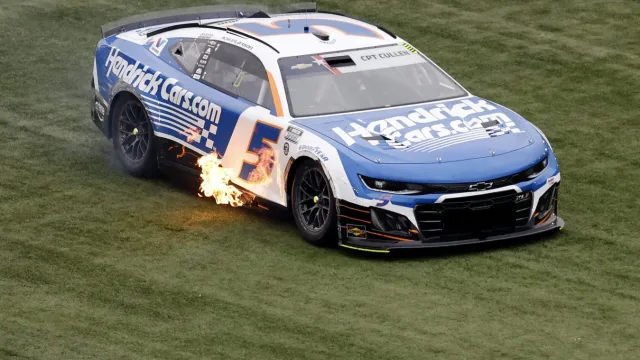Kyle Larson‘s attempt at tackling both the Indianapolis 500 and the Coca-Cola 600 on the same day sparked renewed debate across American motorsports about how the industry can better enable high-profile crossover efforts. Despite setbacks in both races, Kyle Larson’s attempt at Indy 500 and Coca-Cola 600 Double placed the logistical and collaborative challenges of such an endeavor in sharp focus for drivers and teams alike.
Larson’s Day of High Hopes Ends in Disappointment
Kyle Larson entered the weekend aiming for an achievement just four drivers have ever seriously attempted: completing the Indy 500 and then the Coca-Cola 600 in succession. Qualifying in 21st position for the historic Indianapolis event with Arrow McLaren, Larson planned to board a private flight to Charlotte immediately after his open-wheel run. However, rain storms at Indianapolis delayed the start by 43 minutes, shifting the green flag to 1:29 p.m. ET and leaving a smaller buffer for his transition.
Larson’s challenge quickly unraveled at the Brickyard. On Lap 91, he lost control at Turn 2 and struck the SAFER barrier, resulting in a crash that forced him to retire and finish in 27th place. With no time spared, Larson was ferried by helicopter to Concord, North Carolina. Touching down just in time for the pre-race ceremonies, he started the Coca-Cola 600 from the front row, briefly leading laps. Yet misfortune persisted as he was involved in a multi-car accident on Lap 246, leading to another “Did Not Finish” and landing him 37th overall. This series of events mirrored the disappointment of Larson’s prior attempt in 2024, which was cut short due to a rainout in Charlotte.

Calls for a Unified Approach to Cross-Series Challenges
The demanding nature of Kyle Larson’s attempt at Indy 500 and Coca-Cola 600 Double, performed under immense time pressure, captured the attention and respect of many in the motorsports community. In particular, Trackhouse Racing boss Justin Marks, who previously partnered with Kyle Larson, exhorted industry actors to rethink how such crossover feats are supported. Marks, speaking with conviction in a post-race press conference, expressed:
“If I was running everything, I would do everything in my power to make sure things like that Double can happen. Because I think it’s an amazing opportunity for NASCAR fans that want to watch their favorite NASCAR driver, maybe watch the Indy 500 for the first time, learn about IndyCars, learn new stories, and vice versa.” (16:53 onwards)
The comments from Marks, who leads Ross Chastain‘s Trackhouse team, contrasted the prevailing hurdles faced by Larson and underlined the broader value of increased collaboration between sanctioning bodies. While Marks radiated optimism about cross-disciplinary spectacle, Larson, moments after stepping out of his damaged stock car, raised doubts about the practicality of repeating such challenges in today’s environment.
The Daunting Logistics and Historical Precedents
Larson’s remarks reflected frustration about the near-impossible logistics. He admitted that even without the crash at Indianapolis, the narrow time frame would likely have forced him to leave early, undermining the integrity of both races. Of the handful of drivers who have attempted the Double—John Andretti, Robby Gordon, Kurt Busch, and Tony Stewart—only Stewart, in 2001, managed to earn finishes in both contests on the same day, covering all 1,100 combined miles. The rarity of completed Doubles only underscores the demands and planning required for a successful run.
Reflecting candidly after the Coca-Cola 600, Larson said:
“The Double is just a tough undertaking. The window of time is too tight. Even if I didn’t wreck, I don’t think I would have made it here (Charlotte) on time and probably would have had to end that race short anyways. So I don’t really think it’s worth it… Just doing the Double I think is just logistically too tough.”
For many within the paddock, this admission was a sobering reminder of the difficulties involved, even for drivers with substantial resources and organizational support like those from Hendrick Motorsports or Arrow McLaren.
Industry Leaders Advocating for Change
Justin Marks’ passion for a more cooperative industry approach was evident as he called for leaders in both NASCAR and IndyCar to reconsider existing priorities. He shared his empathy and vision for motorsport unity, stating:
“My heart breaks for Kyle… I know how important the speedway is to him. I’m a believer that I don’t think motorsports should be in competition with each other. I don’t think the industry is big enough for us to be trying to make things difficult on each other. I think there’s strength and collaboration between the two.” (16:06 onwards)
Marks pressed fellow decision-makers to transform the Double from a logistical afterthought into an opportunity that strengthens ties across disciplines and builds the broader racing audience. His firm stance comes at a time when only sustained high-profile attempts keep the concept alive in the public’s imagination.
What the Future Holds for the Double
With Larson now pondering whether future attempts are worthwhile, the onus shifts to organizations like NASCAR, IndyCar, Hendrick Motorsports, and Arrow McLaren to assess what changes could enable the Double to flourish. If leaders like Marks succeed in rallying support for greater flexibility and cooperation, the Double might once again become a must-watch event in the American sports calendar, inspiring drivers to take on one of motorsports’ most demanding—and celebrated—feats.
